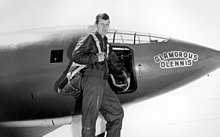Chuck Yeager
Through the NACA program, he became the first human to officially break the sound barrier on October 14, 1947, when he flew the experimental Bell X-1 at Mach 1.05 at an altitude of 45,000 ft (13,700 m), for which he won both the Collier and Mackay trophies in 1948.
In 1962, he became the first commandant of the USAF Aerospace Research Pilot School, which trained and produced astronauts for NASA and the Air Force.
In recognition of his achievements and the outstanding performance ratings of those units, he was promoted to brigadier general in 1969 and inducted into the National Aviation Hall of Fame in 1973, retiring on March 1, 1975 (for its colloquial similarity to "Mach 1").
Throughout his life, he flew more than 360 different types of aircraft over a 70-year period, and continued to fly for two decades after retirement as a consultant pilot for the United States Air Force.
At enlistment, Yeager was not eligible for flight training because of his age and educational background, but the entry of the U.S. into World War II less than three months later prompted the USAAF to alter its recruiting standards.
During his stay with the Maquis, Yeager assisted the guerrillas in duties that did not involve direct combat; he helped construct bombs for the group, a skill that he had learned from his father.
He had joined another evader, fellow P-51 pilot 1st Lt Fred Glover,[20] in speaking directly to the Supreme Allied Commander, General Dwight D. Eisenhower, on June 12, 1944.
[23] In the meantime, Yeager shot down his second enemy aircraft, a German Junkers Ju 88 bomber, over the English Channel.
[25][26] In his 1986 memoirs, Yeager recalled with disgust that "atrocities were committed by both sides", and said he went on a mission with orders from the Eighth Air Force to "strafe anything that moved".
[37] Yeager broke the sound barrier on October 14, 1947, in level flight while piloting the X-1 Glamorous Glennis at Mach 1.05 at an altitude of 45,000 ft (13,700 m)[38][d] over the Rogers Dry Lake of the Mojave Desert in California.
[50][51] Returning to Muroc, during the latter half of 1953, Yeager was involved with the USAF team that was working on the X-1A, an aircraft designed to surpass Mach 2 in level flight.
[52] On November 20, 1953, the U.S. Navy program involving the Douglas D-558-II Skyrocket and its pilot, Scott Crossfield, became the first team to reach twice the speed of sound.
After they were bested, Ridley and Yeager decided to beat rival Crossfield's speed record in a series of test flights that they dubbed "Operation NACA Weep".
[52] The new record flight, however, did not entirely go to plan, since shortly after reaching Mach 2.44, Yeager lost control of the X-1A at about 80,000 ft (24,000 m) due to inertia coupling, a phenomenon largely unknown at the time.
[54] He was a full colonel in 1962,[55] after completion of a year's studies and final thesis on STOL aircraft[56] at the Air War College.
Their job, flying a T-33, was to evaluate Smith Ranch Dry Lake in Nevada for use as an emergency landing site for the North American X-15.
In his autobiography, he wrote that he knew the lake bed was unsuitable for landings after recent rains, but Armstrong insisted on flying out anyway.
When Armstrong did touch down, the wheels became stuck in the mud, bringing the plane to a sudden stop and provoking Yeager to fits of laughter.
In the 2019 documentary series Chasing the Moon, the filmmakers made the claim that Yeager instructed staff and participants at the school that "Washington is trying to cram the nigger down our throats.
"[57][58] In his autobiography, Dwight details how Yeager's leadership led to discriminatory treatment throughout his training at Edwards Air Force Base.
[60][61][62][f] In 1966, Yeager took command of the 405th Tactical Fighter Wing at Clark Air Base, the Philippines, whose squadrons were deployed on rotational temporary duty (TDY) in South Vietnam and elsewhere in Southeast Asia.
[70] During the war, he flew around the western front in a helicopter documenting wreckages of Indian aircraft of Soviet origin which included Sukhoi Su-7s and MiG-21s.
[65][67][71] Yeager also flew around in his Beechcraft Queen Air, a small passenger aircraft that was assigned to him by the Pentagon, picking up shot-down Indian fighter pilots.
[73][74] Edward C. Ingraham, a U.S. diplomat who had served as political counselor to Ambassador Farland in Islamabad, recalled this incident in the Washington Monthly of October 1985: "After Yeager's Beechcraft was destroyed during an Indian air raid, he raged to his cowering colleagues that the Indian pilot had been specifically instructed by Indira Gandhi to blast his plane.
For Enterprise, executive producer Rick Berman said that he envisaged the lead character, Captain Jonathan Archer, as being "halfway between Chuck Yeager and Han Solo".
[87] On October 14, 2012, on the 65th anniversary of breaking the sound barrier, Yeager did it again at the age of 89, flying as co-pilot in a McDonnell Douglas F-15 Eagle piloted by Captain David Vincent out of Nellis Air Force Base.
[94] Regardless of his lack of higher education, West Virginia's Marshall University named its highest academic scholarship the Society of Yeager Scholars in his honor.
[125] In August 2008, the California Court of Appeal ruled for Yeager, finding that his daughter Susan had breached her duty as trustee.
[126][127] Yeager lived in Grass Valley, Northern California and died in the afternoon of December 7, 2020 (National Pearl Harbor Remembrance Day), at age 97, in a Los Angeles hospital.
[128][129] Following his death, President Donald Trump issued a statement of condolences stating Yeager "was one of the greatest pilots in history, a proud West Virginian, and an American original who relentlessly pushed the boundaries of human achievement".








